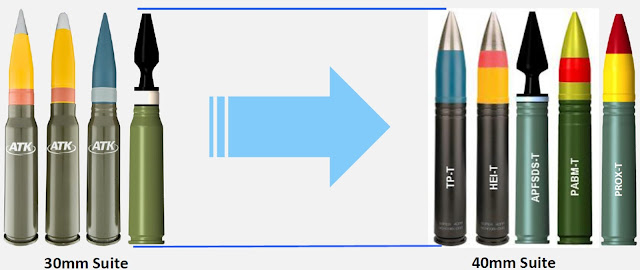The turret similar to the manned version is equipped with two stabilized sight systems for the gunner and commander, with the commander sight having 360 degrees panoramic motion capability.
The ballistic protection offered for the remote version is configurable to provide an optimized weight solution.
The fire control and other capabilities of the remote version is the same as the manned version providing maximum commonality between the configurations.
This also offers a common turret family that can be used in manned and unmanned configurations in fleet of armored vehicles with different missions.
My take on Remote vs Manned Turrets..
These days the remote turrets have become a viable alternative to manned systems. However I do not believe that the remote systems will totally replace the manned systems very soon.
Remote turrets have some drawbacks based on the crew having been located inside the hull with total dependency on the sensors/electro-optics.
Whereas in a two-man turret, the commander's having all around surveillance vision from the highest point of the vehicle or even looking thru the periscopes provide an important advantage in terms of situational awareness which is somehow a lacking capability in remote turrets. In addition, the sighting systems in the remote turrets, cannot include direct view optics, which is also an important requirement in some armies today. Although there are options such as fiber optic sights, the limitations on the number of fibers that can be bundled, degrades the image quality.
Another issue for the remote turrets is the difficulty of the gunner keeping his awareness of the barrel orientation with respect to the vehicle. The gunner is located inside the hull and his sensory feedback only feels the vehicle accelerations; thus after a short while it is not uncommon for the gunner to start having difficulties on where the turret is oriented with respect to the vehicle, especially when the stabilization is turned on.
This can be overcome to some extent by utilizing easy to understand indications on the gunner's display.
I also want to stress another issue that I frequently hear that says the remote turrets offer an important advantage in weight compared with manned turrets. This is not entirely a correct statement. First of all the main difference structurally between a manned and unmanned turret is the elimination of basket structure, crew seating, crew hatches and periscopes in the remote turret concept. On the other hand, you still have to put two seats inside the vehicle for the commander and gunner. Also the displays, handles, structural elements for these still have to be located inside the vehicle. So these are weight-wise not totally eliminated albeit some reduction in the volume invaded compared with the basket swept volume for a manned turret.
However, the ammunition boxes for the main and secondary armament that are generally in the basket for the two-man turret have to be relocated to the turret hull. The hull of the manned turret does not include these, so it usually means you have to increase the turret hull dimensions to accommodate the ammo boxes. As increased dimensions translate to more surface area and more surface area translates to increase in weight, you don’t get to save that much weight by converting to a remote turret.
The trick here is the reduction of protection levels for a remote turret that enables reduction in weight. When you have the crew inside the hull and can accept a reduction in the protection level of the turret, you can save considerable weight by using a remote turret instead of a manned one.
So, in my opinion, the remote turrets although offer some advantages are not the perfect solution to replace all the other turrets.
The correct answer lies in the configuration and mission of the vehicle, such as:
- If the vehicle is a pure IFV that is going to go head to head with the enemy vehicles, two men turrets offering more situational awareness and control over the battlefield would have a definite advantage.
- Again if the vehicle is configured as a personnel carrier - APC, you would need as much room inside as possible, making the remote turret the preferred choice. The US Stryker lethality program is a good example of this approach. US Army naturally does not want to reduce the number of dismounts in the vehicle and thus opted for a remote turret.
- If the vehicle is a reconnaissance vehicle that is to be used for recon-with-fire principle, again the two-man turrets offer more advantages for situational awareness.
- For a reconnaissance platform relying more on electro-optics and sensors following the principle of reconnaissance by stealth, you will need more room inside the vehicle for operators, more displays, consoles, etc. Remote turrets should be preferred.
- For a command platform, again you need more room inside for command consoles, communication equipment, etc. Remote turrets would be a better solution.








